
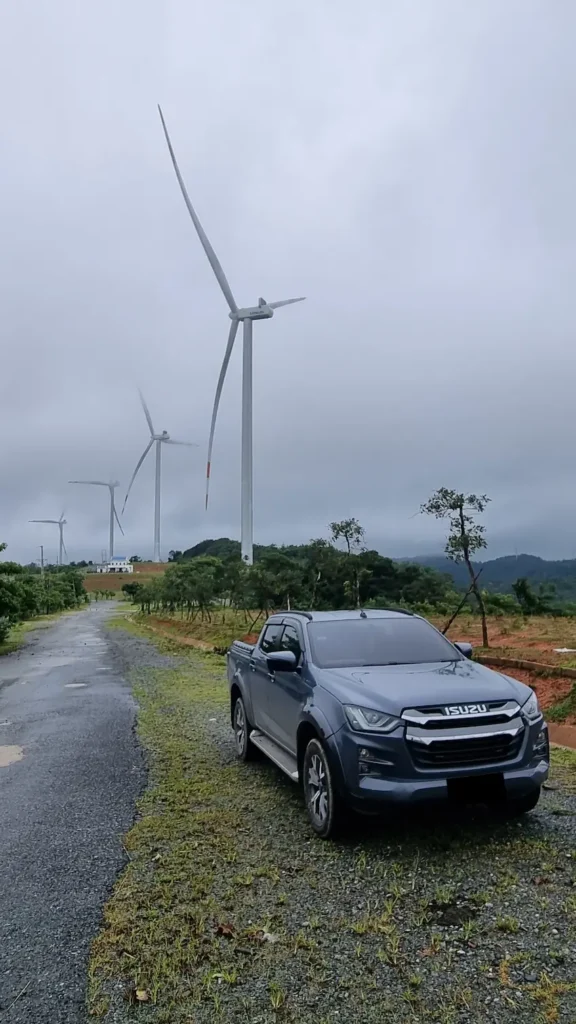
Dreaming of an epic road trip from Laos to Vietnam with your own vehicle (or the vehicle of a spouse, relative, etc)? Whether you’re an expat with a Lao-plated car, retiree or a digital nomad seeking freedom on four wheels, crossing the border into Vietnam can be an unforgettable experience — if you’re prepared.
This guide gives you a practical overview of what it takes to drive a Lao-registered car into Vietnam — legal requirements, paperwork, border crossings and what to expect on the road. I recently did it myself and can report all current requirements for foreigners who want to visit Vietnam with their own vehicle. This guide does not include Lao-Viet border crossings by motorbike, only by car.
Yes, it’s possible to drive a lao car into Vietnam, but only if you have all the necessary car papers and visa (if needed). Vietnam allows Lao-registered private vehicles to enter the country, especially for short stays, tourism, or overland travel. However, it’s not as simple as just showing up at the border — you’ll need to have proper permits and documentation beforehand.
Laos and Vietnam have many different border crossings. While some are smaller, more remote and maybe require a Vietnamese embassy visa before traveling, others are bigger and allow to use an Vietnam eVisa for foreigners. We recently drove from our home base in Savannakhet to the Lao Bao border crossing.
The border town on the Lao side is called Dansavan and the border town on the Vietnamese side is called Lao Bao. It is often referred as Lao Bao border. Lao Bao border crossing is one of the bigger ones. For foreigners who need a Visa for Vietnam, Lao Bao border accepts eVisa, which makes it convenient to use this crossing. Apply for the eVisa well in advance. It takes at least 3-5 working days to process and costs 25 USD.
This is the Official Vietnam eVisa Website: https://evisa.gov.vn
The total distance from Savannakhet City to the Lao-Viet border Dansavan – Lao Bao is around 240 km and takes a bit over 4 hours to reach. When leaving Savannakhet, take the road 9W towards Seno (Xeno). After Seno take road 9E and just keep going until you reach the border. You will pass through Atsaphanghong (Dong Hen), Muang Phalan, Muang Phin and Xepon (Sepon). If you want to break down the journey, there are enough guesthouses on the route to stop for the night. Sepon for example is a mining town and has plenty of options. Not a very appealing city though. Mostly trucks going through and mining companies around.
After crossing the border, it might be a good idea rest and either stay overnight in Lao Bao or continue on to a place called Khe Sanh. You can find the most affordable accommodations on Agoda by following this link 👈
Before hitting the road to Vietnam with your Lao-registered vehicle, make sure your paperwork is in order. Vietnam has specific entry requirements for foreign vehicles and missing even one document could result in being turned away at the border. Here’s a breakdown of the key documents you’ll need to legally and smoothly cross from Laos into Vietnam with your own car.
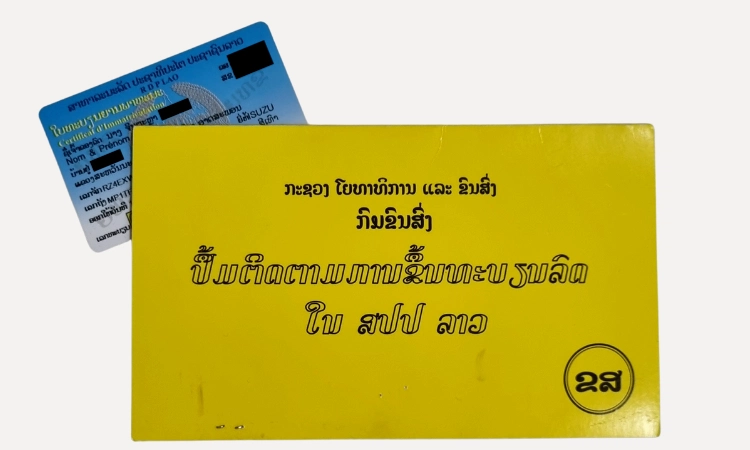
It is necessary to bring the ownership documents of the car with you. Ideally the car is registered under a lao persons name. Otherwise the Vietnamese immigration might cause troubles. It doesn't matter who is driving the car though. So can be a different person as the car owner, as long as the car owner is also on board of the car.
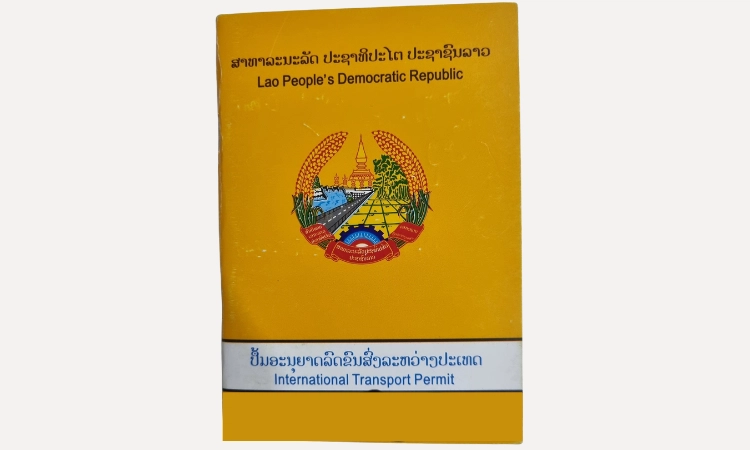
This yellow booklet is the International Transport Permit (or “car passport”) issued by the Lao Department of Transport. It’s required for taking a Lao-registered vehicle across international borders and includes vehicle details, owner info, and space for customs stamps. It’s essential for legal entry into countries like Vietnam, Thailand or Cambodia.
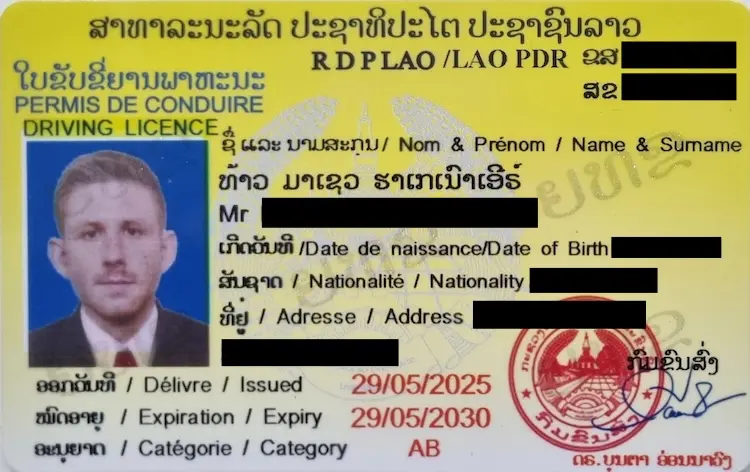
While the Lao side is not strict at all with having a drivers license, the Vietnamese side is. They ask to show a valid driver's license. The driver's license can be a license issued in Laos or a valid international driver's license in combination with the driver's home country license, valid for Vietnam. Here is a guide on how to get a local lao driver's license.
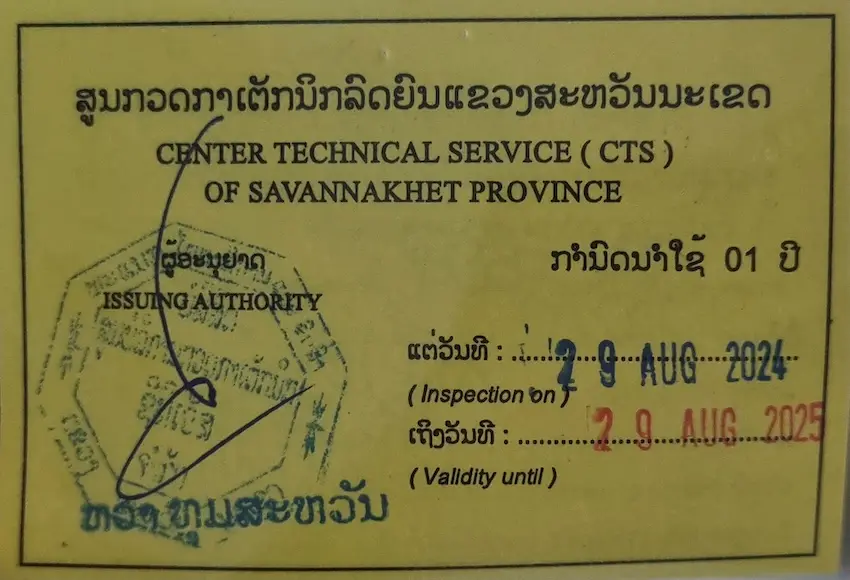
Every car registered in Laos is supposed to have a yearly technical inspection. This can usually be done in cities or district vehicle inspection offices. They check if the car is technically safe to drive on the roads. Also a sticker is issued, which has to be put on the front car window. The technical inspection paper will be checked by Vietnam customs officers.
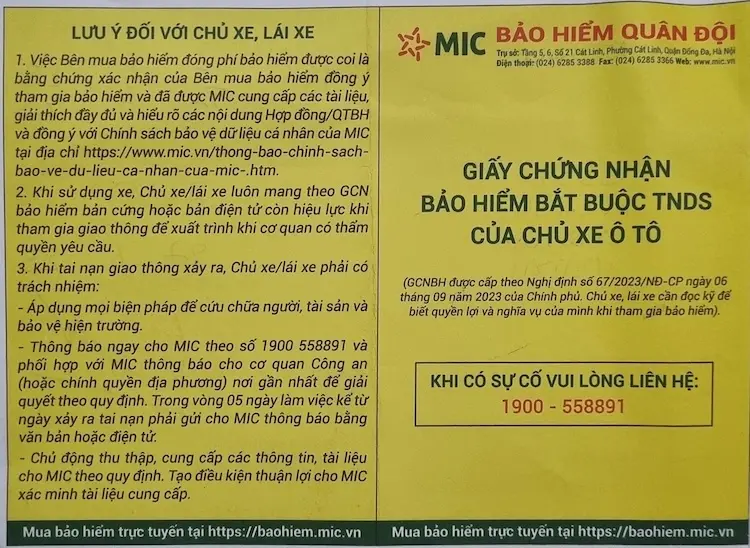
A car insurance can be bought directly at Lao Bao border. It is valid for the same period as the owner of the car is allowed to stay in Vietnam. If the car is registered under a Lao persons name, the validity is 30 days because Lao people can enter Vietnam visa-free for 30 days. Cost was 99.000 VND
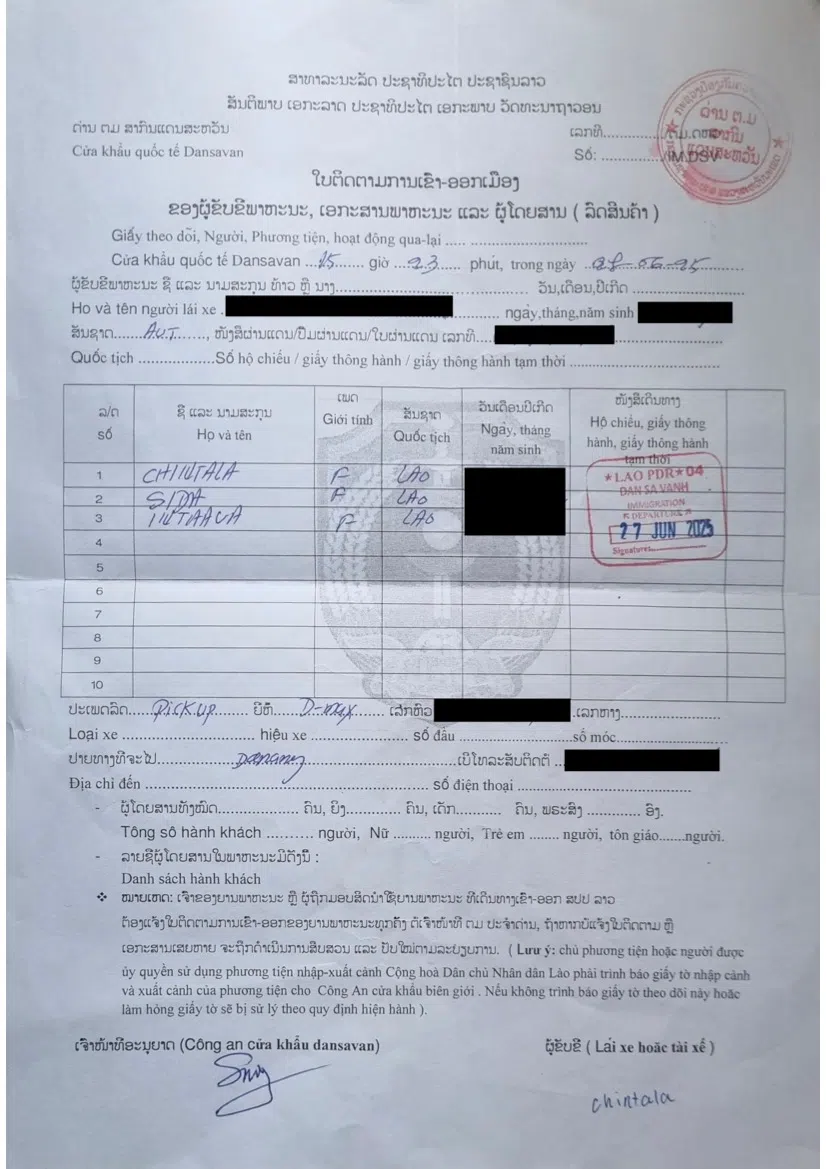
This document is an Entry-Exit Permit issued at the Dansavan International Border Checkpoint in Laos, used to track individuals and vehicles crossing into Vietnam. The Lao side will hand it out to the driver at the border. It includes detailed information such as the driver’s name, nationality, passport or ID details, and vehicle specifications (including type, make, and license plate). It also lists the passengers onboard, their full names, gender, nationality, and birthdate. The permit is stamped by Lao Immigration at the time of departure and signed by both the border police and the vehicle’s driver. This form acts as an official border clearance document and is essential for legal exit from Laos when traveling to Vietnam by car. Keep this paper, because it will be needed when crossing back into Laos.
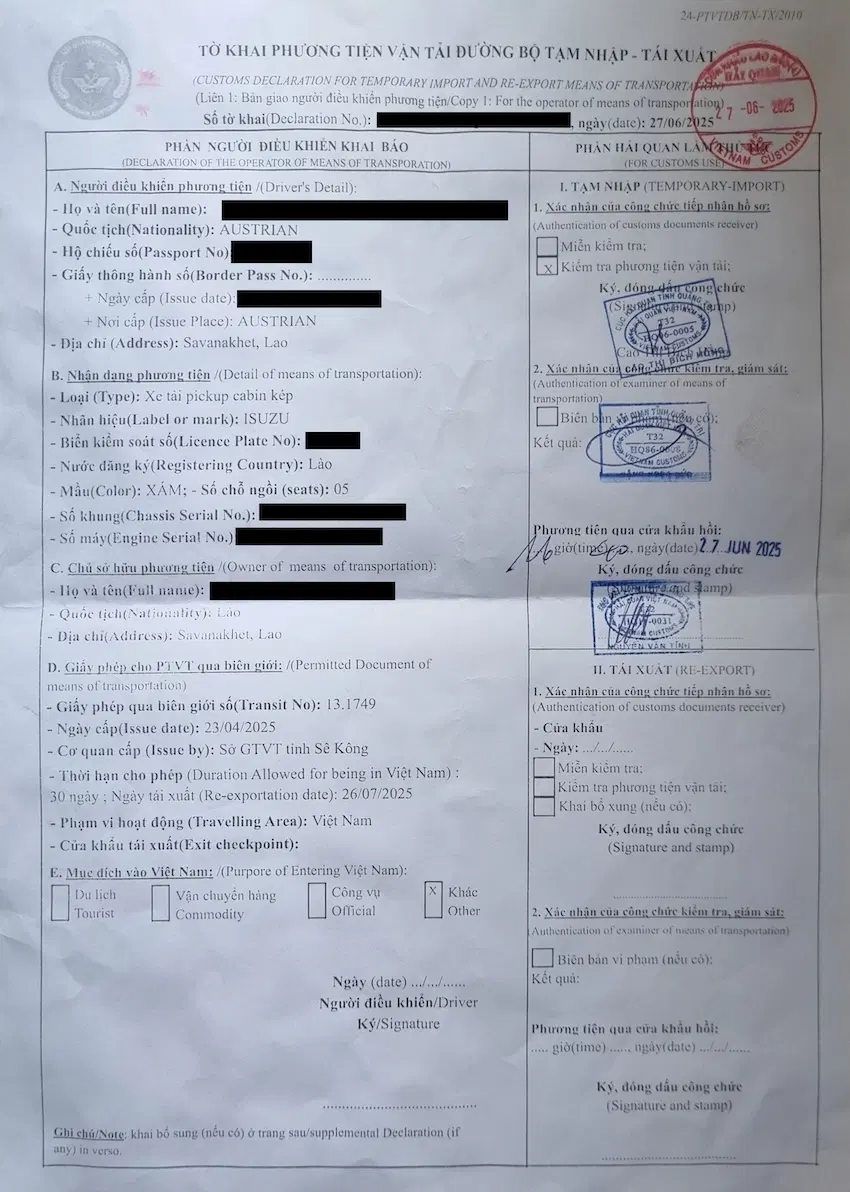
This document is a Vietnamese Customs Declaration for Temporary Import and Re-Export of Means of Transportation, specifically issued for a Lao-registered vehicle entering Vietnam. The Vietnamese side will hand it out to the driver. It contains the driver’s personal details, vehicle information (such as make, chassis number, engine serial number) and ownership data, alongside official stamps and validation from Vietnamese customs authorities. The form includes a transit permit number and outlines the allowed duration in Vietnam — in this case, 30 days — with a set re-export date. The purpose of entry is marked as tourism and the document confirms that both customs document checks and physical inspections were completed. This form is essential for any Lao vehicle planning a legal, short-term stay in Vietnam. Keep this paper because it will be needed again when leaving Vietnam.
Once arrived at the Lao side of the border, park the car and start getting the documents stamped. Take the papers to the Lao customs to receive the necessary stamps. Then hand over all passports of the passengers to get them stamped out of Laos by Immigration. If all documents are in order an properly stamped, they will open the barrier and you can drive through. The exiting process on the Lao side is quite easy and people there are polite.
While Lao officials are quite easy, their Vietnamese counterpart is a bit more strict (and not very polite to be honest). Once you arrived at the Viet side of the border, also park the car, take all papers and get them stamped. Head to the customs officer and they will actually check the car for illegal substances and even look for the engine serial number and if the car is legit. They are quite strict. Passports of the passengers have to be stamped inside the big building. The immigration officers are quite rude and demanding 50.000 VND for stamping the passport. Even I paid for visa already, this is common practice at some land borders. The Vietnamese immigration officer wouldn’t stamp our passports until he received his tea money. An unfriendly immigration officer is not a nice welcome to another country. Anyway you have to deal with those corrupt officials in Vietnam unfortunately.
The necessary car insurance can also be bought inside the building. It costs 99.000 VND for 30 days. After all papers are stampted, car checked, passports stamped and luggage scanned, you can finally continue on. All in all the process on the Vietnamese side takes much longer and immigration officials at the border are corrupt and have no manners. However, that doesn’t reflect a the whole country.
Once you entered Vietnam, you will notice many big differences to Laos. In Vietnam it is very common to honk all the time. Better get used to it and start to do what locals do. Using the horn in Vietnam is not rude, it is normal. When overtaking, turning or whenever you feel it. Very different than Laos, where nobody uses the horn and everything moves slowly. Vietnamese roads can feel quite stressful because there is obviously a lot more traffic than in Laos. Still, people in Vietnam usually follow the speed limits and do not drive crazy fast. Road conditions are very good in Vietnam. Even rural roads were absolutely great compared to Laos. Just get used to the traffic, thousands of motorbikes and all the honking in Vietnam. Overall not difficult at all to drive there, just different than driving in Laos.,
When returning from Vietnam to Laos with a Lao-registered vehicle, it’s generally recommended—but not required—to use the same border crossing as the one used for entry, especially if it’s listed on your temporary import permit. However, check your permit for any specified exit checkpoint, as some crossings are more flexible than others. If you’re a foreigner without a valid Lao visa, you can typically obtain a Visa on Arrival at major land borders or apply for a Lao eVisa in advance. Both options are available at crossings like Lao Bảo-Dansavan, but not all smaller checkpoints support them, so plan accordingly. Currently Dansavan-Lao Bao issues Laos Tourist Visa on Arrival. Lao eVisa can not be used at this border.
Crossing from Laos into Vietnam with a Lao-registered car is absolutely possible — and can be an incredibly rewarding experience — as long as you’re well prepared. From securing the right paperwork and understanding visa requirements to dealing with border officials and navigating Vietnam’s busier roads, this guide gives you a realistic picture of what to expect. While some parts of the process (especially on the Vietnamese side) can be bureaucratic, don’t let that discourage you. With patience, the right documents, and a sense of adventure, driving your own car from Laos into Vietnam opens the door to a whole new level of travel freedom in Southeast Asia. Safe travels and enjoy the ride!
Not always. Some temporary import permits issued by Vietnamese customs specify the exit point. To avoid problems, try to exit at the same crossing you entered — especially if listed on your documents. But if nothing is listed there, you can re-enter Laos at any Lao-Viet border.
Yes, but only if the registered owner is inside the car with you. Vietnamese authorities may deny entry if the car owner is not present. If you’re driving alone and not the owner, you may need an official authorization letter (power of attorney), but this is not guaranteed to be accepted as Vietnam is more strict when entering with an own vehicle.
No. Only certain international border crossings accept the Vietnam eVisa. Lao Bảo (from Dansavan) does, but smaller or remote crossings may require a visa obtained in advance from a Vietnamese embassy or consulate. Always check the official eVisa website: https://evisa.gov.vn
If the car is registered under a Lao citizen, it usually gets a 30-day stay (matching the Lao citizen’s visa-free entry to Vietnam). If it’s a foreign-owned vehicle, the stay may be shorter or require special clearance.
It’s complicated. You would need written permission from the rental company or organization, and most rental agencies do not allow cross-border travel. Additionally, Vietnamese customs may reject cars not registered under a private individual. So chances to cross with a rental car are quite low and might be restricted by the rental contract anyway.